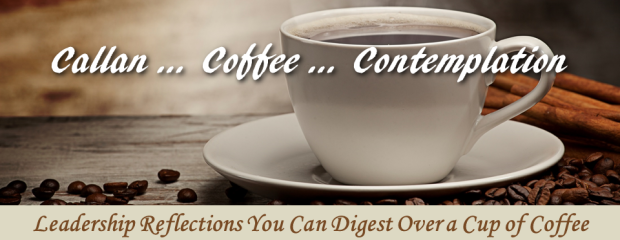Callan … Coffee … Contemplation for the Week of February 17th
Heroic Leaders Possess Self-Discipline
The central maxim of our Callan Course philosophy is this: Great leadership starts with self-leadership; self-leadership starts with self-mastery, and self-mastery is achieved through self-discipline. Self-discipline is a habit born of an intention–achieved by the daily, purposeful allocation of time and energy to mastering ourselves. And like all successful habits, we must combine the intellectual acceptance of the need for the quality (self-discipline) coupled with the tangible actions that create a pattern of behavior.Think here of the master archer: The most crucial thing the archer will ever do to master his craft, to become an expert marksman, is develop self-discipline to master himself—the shooter. Heroic leaders, like the master archer, are also shooters, and our arrows are made of our leadership influence. We will consistently place our arrows of influence in the center of the target by mastering ourselves through self discipline.
Heroic Paradigm – Part II
Our paradigm, the lens through which we view life and leadership, is the most crucial determinant of great leadership. I often describe three basic paradigms that leaders can adopt. The first is accidental leadership, where one devotes almost no thought, preparation, or practice to the art of leadership. The second paradigm is cafeteria leadership, where one simply picks and chooses the leadership actions that fit one’s mood, whim, or disposition. Neither accidental nor cafeteria style paradigms are noble, elevating, or capable of producing greatness. The third and correct paradigm of leading is Heroic Leadership. A Heroic Leadership paradigm is based on a conviction that leadership is a master craft, requiring great exertion, life-long preparation, and daily devotion to self mastery. A Heroic Leader never separates one’s life from one’s leadership. To remain heroic we must constantly clean the lens, transform our eye, and re-tune our ear.
Leadership As A Journey
We refer to leadership as a journey to reinforce this core truth: Leadership is a master craft requiring lifelong development. That leadership is a journey also reminds us that true mastery will always defy instant gratification. To pursue heroic leadership, we must go through life’s test and trials, not around them. There are no menus, checklists, gimmicks, shortcuts, or killer apps we can download to achieve instant leadership mastery. And, though demanding, the journey to heroic leadership is, in the end, its own reward; it calls forth our best selves, and for the groups we lead, it provides a beacon of noble purpose to guide towards the future. The journey’s path can thus be shown, and the terrain described, but each leader must answer the call to heroic leadership and begin walking. Seen correctly, the journey is not just necessary as a means to excellence, but more importantly, the journey is the handmaiden of our character and our significance.
Transformation
There’s been much written about transformational leadership from the vantage point of how leaders transform others. A far more important viewpoint is self-transformation: How Heroic Leaders transform themselves. Self-transformation, borne of the leader’s journey, produces an authentic, centered, and wise leader. Like a diamond imbedded in coal, our heroic self is initially buried under surface level limitations, namely—our egos. And like a diamond, our heroic self will only emerge through crucible-like conditions that burn away the external layers and reveal the hidden gem. Consider this axiom: to reach the high ground of leadership, we must first endure the desert. We must leave our comfort zone, cross thresholds, endure tests, and be re-renewed in the cauldron of experience. The shaping events in our lives, properly understood, create inner conversions—a continual turning around and a letting go. Paradoxically, we must first to go inward, and then and only then–upward and outward.
Heroic Leaders are Resonant
Leadership at its core is influence, and at the core of influence is resonance. Do we resonate with those we lead or not? Consider an orchestra conductor. A great conductor—a maestro–takes a group of disparate musicians and through his artful influence, creates resonance. Resonance is perfect pitch, tone, tenor, and tempo. Beautiful music. This orchestra appears to operate as a single, seamless entity. They have moved from E Pluribus, to Unum (from many, one). Conversely, a bad conductor takes that same group of musicians and due to his lack of leadership influence, creates dissonance. Dissonance is horrible pitch, tone, tenor, and tempo. Like fingernails across a chalk board! Great leaders are maestros; they take once disparate groups—raw elements—and turn them into gold. The gold they create is reflected as unity, cohesion, and shared intent. Leaders become resonant with those they lead by consistently modeling excellence, trustworthiness, and foremost—authenticity. So…do you resonate with your group? To know, look to the quality of the conductor. Be a maestro!
Check back next Monday for a round up of this week’s social media shares. Or check us out on Facebook, Twitter, Google+, or Pinterest to see our posts every day!
Tweet Share






